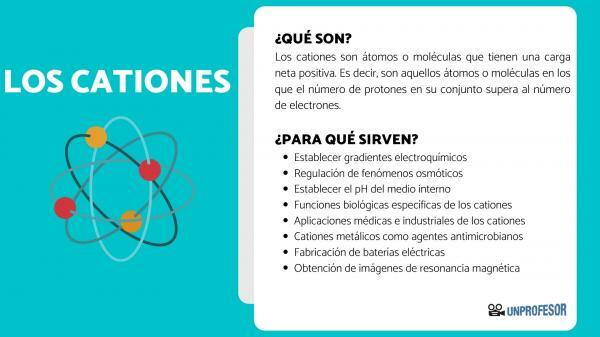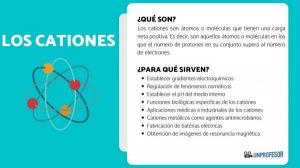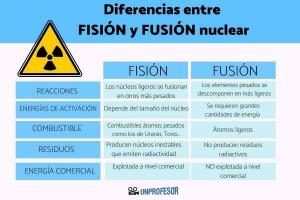What are CATIONS and what are they for
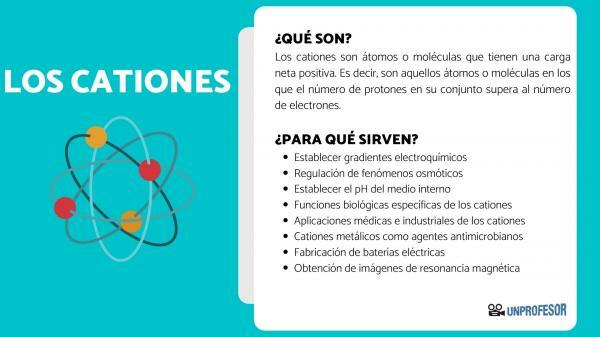
The cations They are chemical species that play a fundamental role in many vital processes and that have multiple applications in industry and medicine. If you want to know in detail what are cations and what are they for, read this lesson from a TEACHER where we explain it to you.
The cations They are atoms or molecules that have a net positive charge. That is, they are those atoms or molecules in which the number of protons as a whole exceeds the number of electrons.
This chemical species is always produced by the loss of electrons, since these are the only charged particles that can leave or join atoms or molecules. This is so, since electrons revolve around the atom nucleus in a set of orbits (which are called orbitals) and which, as a whole, form the electronic cortex, which is the outermost part of the atom.
Cations only occur in free form in solution in polar solvents such as water. In solid form we find them forming part of ionic compounds, combined with anions; forming you go out. Are also found
forming part of metallic substances, in which cations form a network between which electrons move in free form.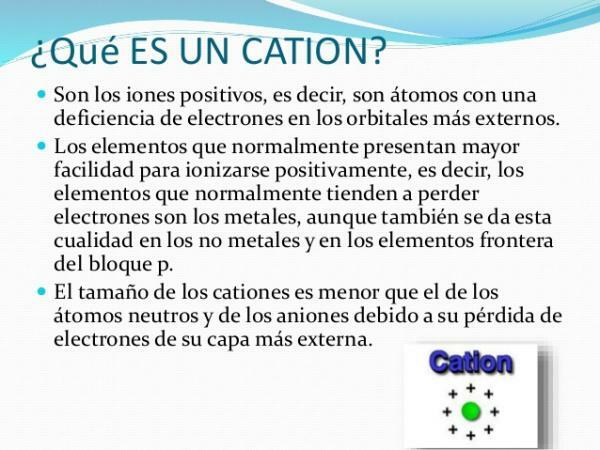
Now that you know what cations are, let's discover the different types that exist. There are two:
- Monatomic cations: Monatomic cations are those formed by a single atom. These are ions of metallic elements, which have a very low ionization energy. This means that they are atoms that are very easily detached from the electrons of their outermost shell (valence shell), to reach the noble gas structure of the previous period. This electronic configuration implies a high stability and the metallic elements acquire cationic forms very easily.
- Polyatomic cations: In this case, they are chemical compounds that are made up of atoms of different elements and that have a net positive charge. They are not very abundant, some examples are: the ammonium ion (NH4+), hydronium (H3O+) or nitronium (NO2+).
Within the polyatomic cations we must also consider organic cations, they are organic compounds (formed by Carbon as the main element) with a positive charge. These types of cations are usually aromatic in nature, that is, they are made up of benzene rings.

Image: Chemistry II
Cations are chemical species, its existence does not imply an intrinsic "utility". However, it is possible to speak of "utility" in relation to both the physical-chemical and biological importance of cations in a multitude of processes or phenomena. physical that may be essential for the proper functioning of the body or its medical applications or industrial processes of interest economic. If you want to know what are cations for, here we leave you a review of its most frequent uses, take note!
Set electrochemical gradients
Cations in general are found in different concentrations in the internal and external environment. This makes it possible to establish electrochemical gradients in media separated by a semipermeable membrane such as the cell membrane. The sodium and potassium cations They are of vital importance for the maintenance of the electrochemical gradient in the internal environment of living organisms. While the cation K+ It is the most abundant in the internal environment of cells, sodium is the most abundant cation in the environment (biotope). Both cations are involved in complex transport mechanisms.
Regulation of osmotic phenomena
Osmosis consists of the passive diffusion (it occurs spontaneously and does not require energy input) of water, through a membrane semipermeable, from a medium with high concentrations of a compound in solution, to a medium in which the concentration of said compound is more low. Therefore, the passage of water through the membrane is determined by the differences in concentration between the internal and external environment of the cell.
Establish the pH of the internal medium
The pH of a solution is the level of concentration of hydrogen ions (H +) in a solution. This parameter is one of vital importance for the survival of organisms and must be kept within narrow limits; to ensure the proper functioning of the enzymes that regulate metabolic reactions and other vital functions.
Specific biological functions of cations
In addition to participating in the maintenance of homeostasis, the pH of the medium or the electrochemical gradients; Some cations carry out specific functions within the body. For example, him calcium cation (Ca2+) is essential in muscle contraction Y the cations sodium (Na +) and potassium (K +) are fundamental in the transmission of electrical impulse along the axon of neurons.
We also find cations associated with organic substances such as proteins or other biomolecules. Is the case ferrous cation (Fe2+) that is forming part of the active center of the hemoglobin and it is essential for the transport of oxygen in the blood. Another example is that of the cation mangnesium (Mg2 +) which is part of the active center of chlorophyll, the photosynthetic pigment of the plants.
As part of salts we find the Calcium in solid form forming part of support or protection structures such as shells, shells and from skeleton.
Medical and industrial applications of cations
Cations have multiple applications in industry and medicine both in their free form (in solution) and as part of salts. Below we will see some examples of the use of cations or salts both industrially and in medicine.
Metallic cations as antimicrobial agents
The silver cation (Ag +) It has bactericidal effects at low concentrations. In medicine, it is used above all in the treatment of burns.
At an industrial level, metal cations, such as copper, zinc or titanium, included in nanoparticles, are also used as antimicrobial agents. In application areas as diverse as textile manufacturing, animal feed, and the pharmaceutical and cosmetic industry.
Manufacture of electric batteries
In the manufacture of electric batteries rechargeableLithium ion (Li+). These are extremely efficient batteries, fast charging and with a useful life that can reach 10 years. Another advantage they have is that they are relatively cheap to produce. These batteries have multiple applications since they are used in mobile phones, laptops and electric cars. The inventors of these batteries, Goodenough, Whittingham and Yoshino, received the Nobel Prize in Chemistry in 2019.
MRI imaging
Cations are paramagnetic, that is, they have a tendency to align themselves parallel to a magnetic field. This property is used in medicine in obtaining images for the diagnosis of disease or injury. Specifically, the technique of obtaining magnetic resonance imaging with contrast. Contrast is an imaging "dye" that is pre-administered to the patient intravenously. The solutions of Gadolinium cation (Gd3+) that binds to organic compounds allowing the formation of images.
